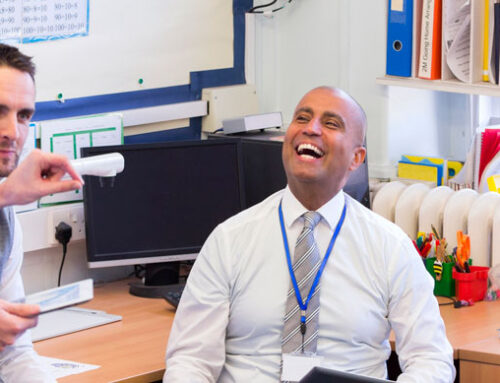As an educator, your main focus is teaching generations to come. However, it’s not your only job requirement. Teachers are expected to attend and even hold teacher meetings. This is often a point of stress for educators. Why?
Teachers’ meetings mean you’ll be collaborating with a group of your peers. To alleviate stress that might come from planning a teacher’s meeting, a good agenda is key. Meeting agendas outline exactly what you plan to address in your meeting. They also help other attendees understand the purpose for the meeting at hand.
Now that you know an agenda is the key, the next step is understanding how to craft the perfect agenda. Below, we’ll walk through what an agenda outline, why each piece is matters, and provide examples in every category.
What Makes a Successful Meeting?
Before outlining a sample teacher’s meeting agenda, let’s look at 3 things that make a staff meeting run more smoothly. Teachers’ meetings are valuable for building and maintaining morale. With these tools in your belt, crafting your own meeting agenda will be simpler.
1. Preparation
The first aspect of creating your meeting agenda is planning and preparation. Without forethought, your meeting will likely struggle in its execution. That’s where an agenda comes in. A shared agenda makes it easier to stay on track and hit all the points you wanted to discuss.
2. Stick to the Point
A productive staff meeting needs order. An agenda helps you outline your meeting so that you don’t deviate very far from what’s scheduled. This is significant because your meeting will be shorter, more direct, and easier to follow than if you stray from the main points. What teacher doesn’t love a clear, concise meeting? With so many demands on their time, short meetings are usually best.
3. Collaboration
Nobody likes sitting in a room being lectured or spoken at. To boost morale, active participant input is vital. Be sure to listen to your team and focus the meeting on their responses. Nothing is worse than a meeting where all the provided information could’ve been sent through an email. Throughout your agenda, remember to plan time for discussion, questions, and staff input.
Sample Agenda for a Teachers’ Meeting
Knowing what makes a teachers’ staff meeting effective is helpful. But, knowing how to create a meeting agenda isn’t so easy.
Without an effective outline, you may stray from the point, lose track of time, and forget imperative points. Below, we’ll walk through some key headings to include in a teachers’ meeting agenda. This way, you can feel confident knowing you crafted something that will make your teachers’ meetings more effective.
Title or Meeting Name

At the top of your meeting agenda should be the meeting heading. Then, include the time, date, and location of the meeting.
Having this section is important, especially if you hand this agenda out to your staff prior to the meeting, so everybody knows the whereabouts of the discussion. Each aspect of the heading has its own significance. The title is a reminder of the main idea of the topics being discussed. For example, if your meeting will center around how students are doing educationally, the title may be “2022 Student Progress Meeting.” The next aspects are relatively self-explanatory. Include the time, date, and location for clarity.
Topic/Main Focus/Introduction
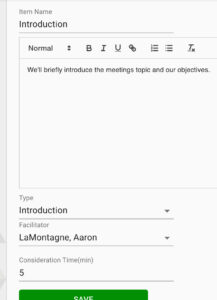
Underneath the heading should be a section for prospective topics. Keep this short and sweet, as they will be expanded on below in the objectives section. Giving a concise version of the planned topics will keep you and your staff focused on the main ideas for the meeting. This also serves as an introduction in your meeting, as meetings often begin with a quick summary of what’s to come.
Continuing from the student progress meeting example above, a topic area could say “Identifying Ways to Improve Student Progress.” This gives more information than the title without going into too many details about what the exact goals are. By providing this topic, it allows you and your staff to understand the main goal of the meeting at hand.
Objectives
While the topic provides a broad overview of what to expect during the staff meeting, it does not identify all the goals for your discussion. This is where the objectives come in. Objectives is an area for pinpointing statements that you and your staff will intend to reach by the end of the meeting time. They typically begin with action words like “review,” “reflect,” and “learn.” Depending on the length and purpose of the meeting, the number of objectives you have will differ.
When crafting your objectives, consider the questions you have and want to address during your meeting. Then, form a specific statement that will work towards answering that question. For example, if you’re wondering how you can improve student progress in the mathematics department, you may pose an objective that reads “Brainstorm strategies to increase mathematics performance in 2023.”
Topics/Agenda Items
The bread and butter of your meeting agenda is the agenda items and activities that you have planned. These should be based around the objectives that you’ve decided. This way your activities and discussions will be centered around completing the necessary tasks to suit your meeting goals. Depending on the length of your meeting, the number of tasks you have will vary. Also, tasks don’t have to be actual “activities.” Simply think of this section as the outline for the meeting. These discussion points should be clear, briefly identify what each activity involves, and account for the entire meeting time. In the case of a student progress meeting, this might look like two activities, each 30 minutes long. One sample activity could be:
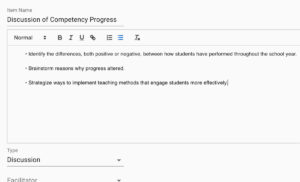
This example provides a title of the task and what is expected from each staff member involved. By breaking down your tasks and activities, you can ensure your staff understands what is required from them and maintain order between tasks.
Estimate the Time
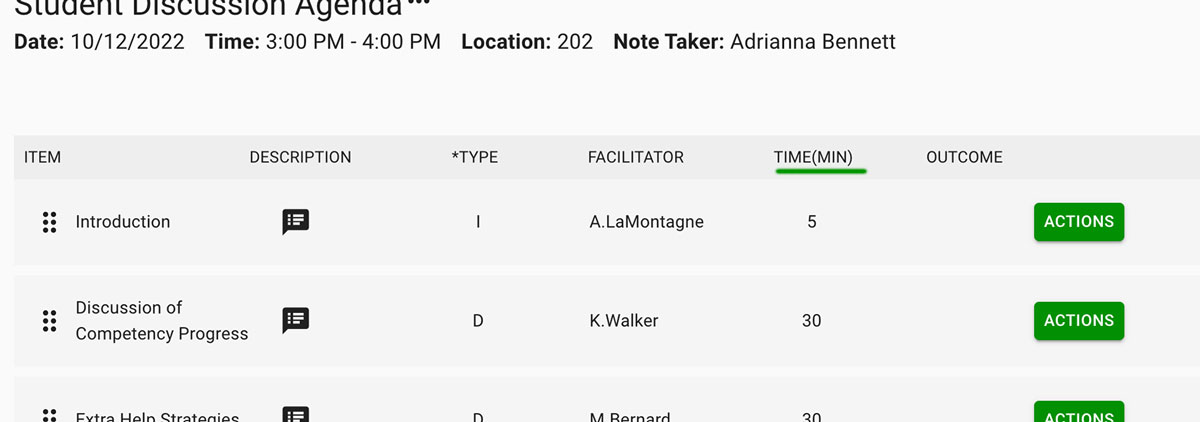
Time is valuable, and you don’t want to waste that valuable time by putting too much focus on topics that could be condensed. Remember, your meetings only have a set amount of time. Once they begin to run over, it’s easy for staff to become antsy and frustrated. For that reason, time planning is essential.
Next to each agenda item, be sure to list the amount of time each should take. This way, you can stick to schedule and ensure that everybody’s focus remains on the task at hand. Estimating time can often be difficult, as you must consider how long the participants will take. This ranges between group and individual.
As a rule of thumb, there are a few things to keep in mind: item difficulty, group focus, and how in-depth the activity is. For more difficult or dense tasks, allot more time. If you were assigning a group the task of creating a flow chart of the chain of teaching for a specific subject, you may allow 15 minutes. This gives time for participants to brainstorm and write out a physical chart to present. Assigning too much time gives unnecessary free time, while too little time can lead to stress, rushed work, and unfinished pieces.
Debrief
At the end of your meeting, a debrief is essential. In this time, you can give a full summary of what was determined throughout the teachers’ meeting. It also allows fellow educators to voice their opinion and advice about whatever was discussed. A debrief plays the important role of allowing collaboration, as it shows the group you are willing to listen to their feedback. On an agenda, your debrief section will likely not be detailed, as the group will lead the discussion.
Resources and Next Steps

The final category of your teachers’ meeting agenda should be a “resources,” or “next steps,” section. Here, you will list any resources that you utilized during your meeting so that you and your staff can reference back to it when necessary. The next steps should indicate whether there are further actions that participants should take after the meeting. For example, this could be “implement one strategy discussed and document the results for our next meeting.” It could also be a good time to assign tasks to team members, or review tasks that were assigned during the meeting. This section plays a valuable role to your meeting’s conclusion since it won’t leave participants hanging and serves as a clear endpoint to your discussion.
Share the Agenda
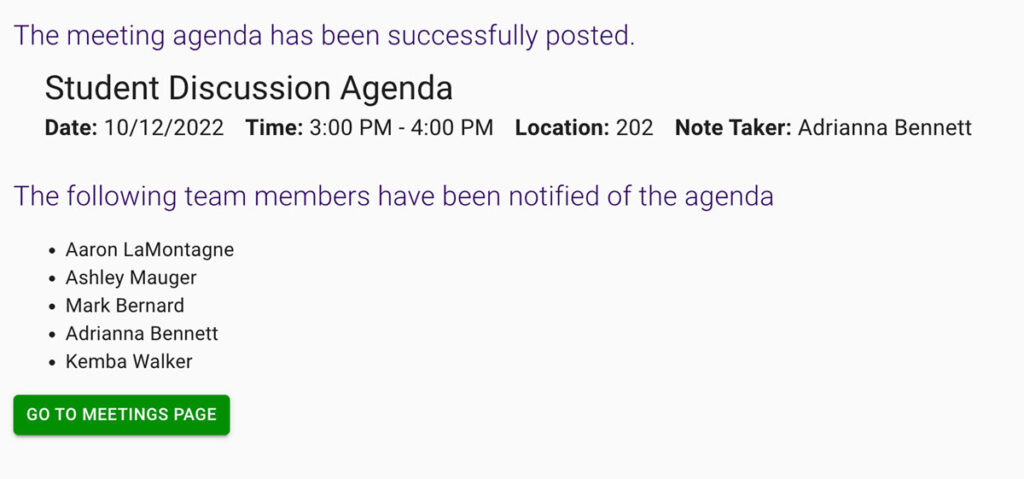
You want to make sure all team members will have access to the agenda, as this will help them prepare for the meeting and stay engaged. You can email staff a copy of the agenda. Using a tool like Team Agendas will allow you to ‘post’ the agenda, which will automatically email it to the assigned team members. If changes are made to the agenda, the agenda email will be sent with the updates.
An effective agenda is one of the keys to a successful meeting. Hopefully this sample agenda has has given you some idea for how to craft one of your own for an upcoming teachers’ meeting.
Create Your Own Teacher’s Meeting Agenda
With the provided outline, we hope you feel more comfortable crafting an agenda of your own for your upcoming teacher’s meeting. If you are confident, prepare beforehand, and include all the necessary headings for your meeting, your discussion should run smoothly. Be sure to include all participants for the most effective meeting possible. Hopefully this sample agenda has has given you some idea for how to craft one of your own for an upcoming teachers’ meeting.With an effective meeting agenda, you can expect a well-planned and engaging teacher’s meeting!





